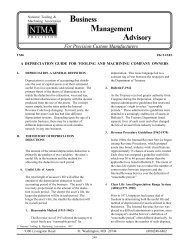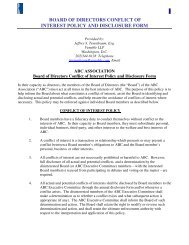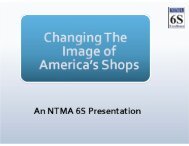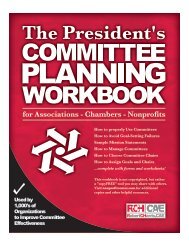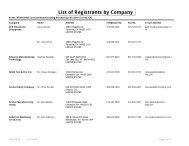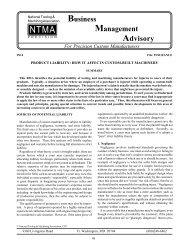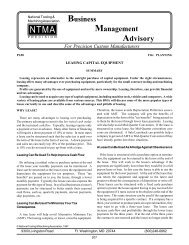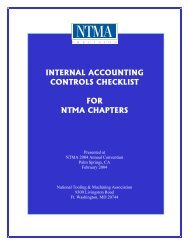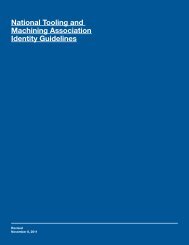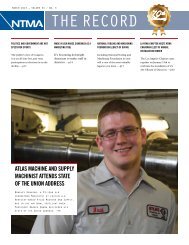Establishing A Quality System for Defense Work - National Tooling ...
Establishing A Quality System for Defense Work - National Tooling ...
Establishing A Quality System for Defense Work - National Tooling ...
Create successful ePaper yourself
Turn your PDF publications into a flip-book with our unique Google optimized e-Paper software.
<strong>National</strong> <strong>Tooling</strong> &<br />
Machining Association<br />
NTMA<br />
P R E C I S I O N<br />
Business<br />
Management<br />
Advisory<br />
For Precision Custom Manufacturers<br />
TC14<br />
File: TECHNICAL<br />
ESTABLISHING A QUALITY SYSTEM FOR DEFENSE WORK<br />
SUMMARY<br />
The stringent quality specifications associated with defense work have long been the industry “standards” <strong>for</strong> many<br />
non-defense applications as well. Are they really any tougher than the specifications of your commercial customers<br />
Probably not: but they are very specific and they do require you to “have your act together” in regard to quality. A<br />
true quality control program is much more than just an inspection system. It helps you do things right the first time and<br />
thus increases productivity. This BMA will help you get started on your company’s individual quality program whether<br />
you intend to use it <strong>for</strong> government or commercial work only.<br />
GETTING QUALIFIED<br />
If your company, like many others, is looking into defense<br />
business <strong>for</strong> the first time, you’re probably confused by the<br />
many vague references to standards, mil specs, and other<br />
requirements relating to quality control. This BMA is aimed<br />
at clearing up some of the confusion on the quality requirements<br />
of the Department of <strong>Defense</strong>.<br />
The government’s basic Inspection <strong>System</strong> Requirements<br />
are described in a standard known as MIL-I-45208A. This<br />
document is approved by the Department of <strong>Defense</strong> and is<br />
mandatory <strong>for</strong> use by the Army, Navy, Air Force, and the<br />
<strong>Defense</strong> Supply Agency. Thus, if you meet this standard, you<br />
meet the basic requirements <strong>for</strong> all defense agencies.<br />
Another standard, MIL-Q-9858A, “<strong>Quality</strong> Program Requirements,”<br />
provides a higher-level series of requirements<br />
than MIL-I-45208A. This higher-level standard is also used<br />
by all U.S. defense agencies and includes all of the provisions<br />
of MIL-I-45208A, plus additional quality control programs.<br />
There<strong>for</strong>e, if you comply with MIL-Q-9858A, you automatically<br />
meet the requirements of the lower level MIL-I-45208A.<br />
A third standard, MIL-STD-45662, “Calibration <strong>System</strong>s<br />
Requirements,” is referenced and included as part of the other<br />
two standards. This document specifies the steps that must be<br />
taken to insure that your measuring instruments are properly<br />
calibrated and controlled.<br />
The central source <strong>for</strong> all military standards and specs is the<br />
Naval Forms and Publications Center, 5801 Tabor Avenue,<br />
Philadelphia, PA 19120, (215) 697-2000. The documents are<br />
free, but service can be slow. Order <strong>for</strong>ms (DD <strong>for</strong>m 1425) are<br />
available upon request.<br />
A commercial supplier of government standards is the<br />
<strong>National</strong> Standards Association, (800) 525-7052. They sell<br />
what the government gives away, but they provide a faster<br />
service. A free catalog is available upon request.<br />
If you just want to get the quality standards to get your<br />
company geared up <strong>for</strong> government work or if you need to<br />
meet a bid deadline in a hurry, you might be better off<br />
ordering your needed specifications from one of the several<br />
commercial sources.<br />
Either the <strong>Defense</strong> Department or any of the commercial<br />
sources can supply any of the other more specific mil specs<br />
that may be called out in any particular <strong>Defense</strong> contract.<br />
Document packages may also be available directly from the<br />
contracting officer or from the purchasing agency on some<br />
government jobs.<br />
MIL-I-45208A states that “The contractor’s inspection<br />
system shall be documented ....” This is the heart of the<br />
military inspection and quality system and the place <strong>for</strong> that<br />
documentation is in your company’s quality manual.<br />
Your quality manual will have to be developed especially<br />
<strong>for</strong> your particular company. There are no universal quality<br />
manuals ready-to-use right from the bookseller. Your quality<br />
manual will be unique to your company, your organization,<br />
and the kind of work your company does.<br />
The various ready-made quality manuals are really only<br />
guidelines. This is also true of the standards MIL-I-45208A,<br />
MIL-STD-45662 and MIL-Q-9858A, even though they are<br />
mandatory when referenced. They tell you what must be<br />
covered in your inspection system, in your calibration system,<br />
and in your quality program, but you must still work out the<br />
© <strong>National</strong> <strong>Tooling</strong> & Machining Association, 1997<br />
9300 Livingston Road Ft. Washington, MD 20744 (800)248-6862<br />
297
details as they apply to your company. For example, MIL-<br />
STD-45662 requires you to have a regular schedule <strong>for</strong> calibrating<br />
your measuring instruments, but leaves you with the task of<br />
working out your own schedule based upon your own applications,<br />
needs, and requirements.<br />
Your company’s quality manual is the “roadmap” that<br />
documents and describes the ways your company meets the<br />
government’s requirements <strong>for</strong> inspection, calibration and<br />
quality systems and programs. Here is a summary of some of<br />
the highlights of the three standards we’ve been discussing so<br />
far:<br />
MIL-I-45208A describes the requirements <strong>for</strong> Inspection<br />
<strong>System</strong>s only. It does not address quality assurance provisions,<br />
preparation <strong>for</strong> delivery, nor other areas beyond the<br />
inspection system itself. The contractor’s inspection system<br />
must be documented (written down) and must be available <strong>for</strong><br />
review by the government’s representative.<br />
The standard describes exactly what is to be documented<br />
and how. For example, instructions must be provided <strong>for</strong> the<br />
inspection and testing of materials, work in progress, and<br />
finished articles, and records must be kept of inspections and<br />
their results.<br />
The standard also makes the contractor responsible <strong>for</strong><br />
providing and maintaining “gages and other measuring and<br />
testing devices” and <strong>for</strong> having such gages and instruments<br />
calibrated “at established intervals” in accordance with MIL-<br />
STD-45662 (which covers calibration system requirements).<br />
Minimum standard procedures <strong>for</strong> inspecting governmentsupplied<br />
materials are prescribed, and responsibility <strong>for</strong><br />
various other items is fixed, including corrective action <strong>for</strong><br />
deficiencies; ways of identifying the inspection status of<br />
materials and goods: engineering changes, non-con<strong>for</strong>ming<br />
material; alternate means of inspection; government inspections<br />
and subcontracted work.<br />
It is important to remember that these requirements are<br />
mandatory only on government work where the standard is<br />
specifically referenced. However, once the necessary documentation<br />
is set up, you can use the same documented<br />
inspection system <strong>for</strong> all government work requiring MIL-I-<br />
45208A and the same methods can be used to provide a<br />
systematic approach to your commercial work.<br />
MIL-STD-45662 requires contractors to have a system <strong>for</strong><br />
calibration of instruments and gages used <strong>for</strong> inspection and<br />
testing. The contractor must also be able to provide “objective<br />
evidence” of accuracy, subject to spot checks by the<br />
government’s representative.<br />
The calibration system must be described in writing and<br />
must identify the intervals at which various instruments are<br />
calibrated as well as the calibration sources. Calibrations<br />
may be per<strong>for</strong>med by outside contractors or by your own<br />
personnel as long as all documentation requirements are met.<br />
Outside calibration services can usually assist with your<br />
documentation paperwork, but your company, as the contractor,<br />
is responsible to the government. Your company is also<br />
responsible <strong>for</strong> the accuracy of employee-owned instruments<br />
used in the shop and your system should provide <strong>for</strong> checking<br />
and calibrating these tools as well. You are also held<br />
responsible <strong>for</strong> the accurate calibration of your subcontractors’<br />
equipment.<br />
The calibration intervals <strong>for</strong> various instruments can vary<br />
based on stability, purpose, degree and severity of usage, and<br />
so on. You may also adjust the calibration schedules based upon<br />
documented past experience, but the intervals must be specified.<br />
Calibration procedures <strong>for</strong> the various instruments must be<br />
available in writing, although manufacturer’s instructions<br />
will meet the requirement. The calibration system description<br />
must also identify and keep track of serial numbers and calibration<br />
date and status of reference and transfer standards (shop<br />
masters).<br />
Finally, MIL-STD-45662 requires procedures to analyze<br />
and correct products tested by instruments found to be out of<br />
tolerance. Procedures are also required to evaluate the<br />
calibration system itself. If your company regularly uses<br />
calibration service, or if you have a full-time inspector or<br />
inspection department, you are probably already meeting<br />
many of the requirements of this standard.<br />
MIL-Q-9858A includes all of MIL-I-45208A’s requirements<br />
<strong>for</strong> inspection systems, as well as MIL-STD-45662’s<br />
requirements <strong>for</strong> calibration systems, and adds further requirements<br />
<strong>for</strong> achieving a complete quality program. MIL-<br />
Q-9858A requires the contractor to establish an effective<br />
program <strong>for</strong> quality that will permit control “at all points<br />
necessary to assure con<strong>for</strong>mance” to contract requirements.<br />
The standard sets up specific requirements <strong>for</strong>: management,<br />
organization and planning of the quality program; work<br />
instructions; record-keeping; corrective actions; costs related<br />
to quality; facilities and standards <strong>for</strong> equipment, drawings,<br />
and tooling; control of purchases; and manufacturing controls.<br />
Additional requirements are also established <strong>for</strong> some<br />
of the areas covered in the lower level MIL-I-45208A.<br />
The important distinction between MIL-I-45208A and<br />
MIL-Q-9858A is that one establishes requirements <strong>for</strong> an<br />
inspection system while the other provides <strong>for</strong> a comprehensive<br />
quality program. A program such as the one required by<br />
MIL-Q-9858A is designed to help your company “do the job<br />
right the first time.” Since MIL-Q-9858A has been proven in<br />
practice by thousands of companies, it provides an excellent<br />
starting point <strong>for</strong> establishing a quality program even if<br />
you’re not interested in doing government work.<br />
In the meantime, <strong>for</strong> “homework” you can get copies of the<br />
standards themselves and start studying them. If you already<br />
have a quality program, you might want to make sure it’s upto-date.<br />
Also, it would be helpful to review the Guidelines <strong>for</strong><br />
Government Procurement and Marketing found in your NTMA<br />
Business Management Advisories under “Marketing.”<br />
MIL-Q-9858A: THE BASIS FOR YOUR QUALITY<br />
PROGRAM<br />
Although it is natural that we often associate the term<br />
“quality” with inspection, it is important to bear in mind that<br />
inspection is only one element of a quality program. A<br />
company can use very stringent inspections to wind up<br />
rejecting 50 percent of its parts be<strong>for</strong>e shipping - but that’s<br />
hardly what anyone would call a quality operation.<br />
Thus, a full quality program helps prevent rejects be<strong>for</strong>e<br />
they get to the final inspection stage. Preventing defective<br />
parts and rework throughout your production process can<br />
298
obviously go a long way toward improving your overall<br />
productivity and profits. In fact, a good quality program can<br />
actually result in a reduced need <strong>for</strong> inspection through<br />
systematic improvements in quality at all stages of processing.<br />
Many of the administrative control elements of MIL-Q-<br />
9858A require documentation—and in the past, that has<br />
meant paperwork. However, even the small, tabletop computers<br />
found in many small plants can help to greatly simplify the<br />
recordkeeping and documentation requirements of MIL-Q-<br />
9858A.<br />
As you study MIL-Q-9858A to plan your company’s quality<br />
program, you can begin developing your own quality<br />
manual at the same time. Your quality manual will be a<br />
specially prepared document, unique to your company, which<br />
describes how your company meets the requirements of the<br />
standard.<br />
First, let’s take a look at the eight major headings within<br />
MIL-Q-9858A:<br />
1. Scope<br />
2. Superseding, Supplementation and Ordering<br />
3. <strong>Quality</strong> Program Management<br />
4. Facilities and Standards<br />
5. Control of Purchases<br />
6. Manufacturing Control<br />
7. Coordinated Government/Contractor Actions<br />
8. Notes<br />
Your quality manual can be easily organized to correspond<br />
with the organization of the standards itself, at least at first.<br />
As you revise and refine your program, you might want to try<br />
some different approaches. But <strong>for</strong> now, let’s stick to the<br />
standard.<br />
Each time you see the words “shall” or “must” in the<br />
specification, you need to add a statement to your quality<br />
manual dealing with each requirement as it affects your plant.<br />
Now, get a copy of the specification and refer to it as you read<br />
through this BMA. Ready<br />
Part one of MIL-Q-9858A covers the specification’s scope,<br />
including applicability, contractual intent, a summary, relation<br />
to other contract requirements and relation to MIL-I-<br />
45208 (Inspection <strong>System</strong> Requirements).<br />
Part two simply covers the requirements <strong>for</strong> keeping current with<br />
the latest revisions and amendments of the specifications involved.<br />
The real “meat” of the specification begins in part three,<br />
“<strong>Quality</strong> Program Management.” The introduction to your<br />
quality manual might cover everything in the specification<br />
through “Organization” and “Initial <strong>Quality</strong> Planning.” It is<br />
important that your manual contain a personal statement of<br />
commitment to quality from the company’s chief executive at<br />
the very beginning. Responsibility <strong>for</strong> quality must extend to<br />
all employees, but top management must ultimately take<br />
responsibility <strong>for</strong> the success or failure of the quality program.<br />
Your manual’s introduction should contain at least: a) a<br />
statement of commitment to quality from the chief executive;<br />
b) a simple organization chart showing the chain of command<br />
and responsibilities <strong>for</strong> your quality program; c) an overview<br />
or outline of the scope of your quality program; and d) a<br />
statement or listing of the government and/or commercial<br />
standards and specifications the program is designed to meet.<br />
Part three of MIL-Q-9858A continues with subheadings on<br />
requirements <strong>for</strong> work instructions, records, corrective action<br />
and costs related to quality. These items should each be<br />
covered in detail in the body of your quality manual.<br />
The purpose of requiring explicit written procedures, records<br />
and so on is to insure uni<strong>for</strong>mity and consistent repeatability<br />
in your operations. Thus, the written materials serve as “how<br />
to” instructions <strong>for</strong> your employees and also help<br />
management’s ef<strong>for</strong>ts to plan, schedule and control.<br />
General procedures should be detailed in the quality manual.<br />
If you intend to meet MIL-Q-9858A, be sure that you specifically<br />
address each of the requirements under each subheading<br />
as it applies to your company. Specific instructions and<br />
procedures <strong>for</strong> individual contracts can be spelled out in shop<br />
work orders or routing tickets.<br />
Section four of the specifications covers “Facilities and<br />
Standards” and begins by requiring you to establish a method<br />
of keeping up-to-date on drawings, documentation and engineering<br />
changes. Smaller companies handling small contracts<br />
can usually meet this requirement just by assigning one<br />
individual the responsibility to assure that prints, specs and<br />
change notices being used throughout the plant are current.<br />
Larger companies dealing in more complex contracts will<br />
require a more structured approach, but in either case, the<br />
methods must be specified in your quality manual.<br />
The Facilities and Standards section of MIL-Q-9858A also<br />
contains the requirements <strong>for</strong> measuring and testing equipment,<br />
including the requirements <strong>for</strong> calibration of instruments<br />
according to MIL-STD-45662, Calibration <strong>System</strong><br />
Requirements.<br />
As you may recall, MIL-STD-45662 requires that you<br />
establish a regular, periodic calibration program but allows<br />
you to establish your own calibration intervals. The calibration<br />
schedule can be revised, based upon experience, but it<br />
must be documented and specified in your quality manual.<br />
Contract calibration services and instrument suppliers can<br />
suggest appropriate schedules <strong>for</strong> your plant’s inspection<br />
equipment.<br />
This section of MIL-Q-9858A also provides <strong>for</strong> “proving<br />
out” production tooling which will be used as inspection<br />
media. Periodic checking intervals <strong>for</strong> such tooling should<br />
also be specified. Section four concludes by stating the<br />
government customer’s right to spot check gages and measuring<br />
instruments in your plant and by providing <strong>for</strong> special<br />
arrangements if highly advanced measurement techniques are<br />
required.<br />
The next section deals with control of purchases. The<br />
government makes the contractor responsible <strong>for</strong> assuring<br />
that all supplies and services from vendors and subcontractors<br />
con<strong>for</strong>m to the contract requirements.<br />
As the contractor, MIL-Q-9858A requires you to use<br />
“objective evidence” of effective quality control by your<br />
suppliers. This responsibility extends to a) the selection of<br />
qualified vendors; b) transmitting the contract’s quality<br />
requirements to the vendor; c) evaluation of vendor’s products<br />
or services; and d) effective methods <strong>for</strong> corrective<br />
299
measures. Test reports, inspection records, certificates and<br />
other documents can be used to provide evidence of consistent<br />
quality.<br />
Your quality manual can meet these purchasing control<br />
requirements by stating your procedures and recordkeeping<br />
methods <strong>for</strong> controlling vendor per<strong>for</strong>mance. Using fully<br />
documented written purchase orders <strong>for</strong> all supplies will also<br />
help keep your requirements explicit and can help to avoid<br />
mistakes or disputes. It is particularly important to reference<br />
all government specs involved in purchase orders <strong>for</strong> subcontract<br />
work or supplies including drawings, engineering change<br />
orders, specifications, any special per<strong>for</strong>mance or safety<br />
requirements, unusual test requirements and so on.<br />
The longest section of MIL-Q-9858A deals with Manufacturing<br />
Control. Control of incoming materials is the first item<br />
covered, requiring provisions <strong>for</strong> receiving inspection. It<br />
specifies that outside test labs may be utilized when necessary.<br />
You must also require your subcontractors to use<br />
“equivalent controls” <strong>for</strong> material used in parts <strong>for</strong> your<br />
contract. Methods of identifying material and its inspection<br />
status must also be used. This is usually accomplished by a<br />
combination of tagging and marking. Whatever methods you<br />
choose should be specified in your manual.<br />
On the subject of production processing and fabricating,<br />
the specification requires you to assure that machining,<br />
assembly and other operations take place under “controlled<br />
conditions.” These controlled conditions primarily refer to<br />
written work instructions, as on job tickets or routing slips.<br />
Controlled conditions are also interpreted to include adequate<br />
equipment and there<strong>for</strong>e, your quality manual should<br />
also mention your machine maintenance program.<br />
Inspection and monitoring at each work operation are<br />
necessary, and inspection procedures and results should also<br />
be recorded. Furthermore, the criteria <strong>for</strong> acceptance and<br />
rejection and ways of identifying acceptable and rejected<br />
parts must be specified. The specification also notes that<br />
special exotic situations may also require additional documentation.<br />
These obligations must be detailed separately <strong>for</strong><br />
the requirements of each job, but developing a simple systematic<br />
method with control <strong>for</strong>ms that can be used routinely will<br />
greatly simplify this task.<br />
Your control <strong>for</strong>m should have space <strong>for</strong> written instructions <strong>for</strong><br />
machining and <strong>for</strong> inspection. It should specify the drawing number,<br />
contract or job number, material, machine to be used, tooling, setup<br />
in<strong>for</strong>mation, identification of appropriate NC tapes or programs and<br />
any other pertinent details. Space may be provided <strong>for</strong> a sketch on<br />
the <strong>for</strong>m itself or drawings may be attached.<br />
If your work usually involves quantity runs, a separate <strong>for</strong>m<br />
can be used <strong>for</strong> inspection results, identifying only the job<br />
number, batch date, work station, operation and results. If<br />
your work tends to be in small lots, this in<strong>for</strong>mation could be<br />
on the reverse side of the job ticket itself.<br />
The specification requires a system <strong>for</strong> final inspection and<br />
testing of completed products. The standard states that “Such<br />
testing shall be per<strong>for</strong>med so that is stimulates, to a sufficient<br />
degree, product end use and functioning” (emphasis added).<br />
Obviously, simulation of many defense products’ end use<br />
in a machine shop can be virtually impossible. If there is any<br />
question as to what constitutes “a sufficient degree,” get the<br />
answer in writing from your contract officer.<br />
Handling, storage and delivery of government work is also<br />
covered in the specification’s section on manufacturing controls.<br />
<strong>Work</strong> and inspection instructions must also cover<br />
handling, storage and shipping considerations. Special crates,<br />
boxes, wrappings, etc. must be used when parts require protection<br />
in handling.<br />
If parts are to be stored at your facilities, they must be<br />
periodically inspected <strong>for</strong> deterioration or damage. Any<br />
special storage or handling requirements must be noted on<br />
containers or in the storage areas. The quality program must<br />
also include provisions to assure compliance with ICC regulations<br />
on shipping and must monitor shippers’ protection of<br />
products in transit.<br />
The contractor is required to “establish and maintain” an<br />
effective and positive system <strong>for</strong> controlling noncon<strong>for</strong>ming<br />
material. Requirements include specifying procedures <strong>for</strong><br />
keeping such material segregated, getting clearance <strong>for</strong> rework<br />
and tracking costs associated with noncon<strong>for</strong>ming<br />
materials.<br />
The use of statistical quality control methods is permitted<br />
under MIL-Q-9858A even when the contract does not specifically<br />
require such techniques. The use of statistical methods<br />
is permitted whenever such procedures are appropriate to<br />
improve quality control. Effective use of statistical techniques<br />
can actually reduce your inspection requirements,<br />
saving time, labor and money. We’ll discuss statistical<br />
quality control at greater length elsewhere, but <strong>for</strong> right now,<br />
you can note that the government specs on statistical quality<br />
control most often used <strong>for</strong> tooling and machining work are<br />
MIL-STD-105, and to a lesser extent, MIL-STD-414, or<br />
Handbooks H-106, 107 and 108. If you elect to use some other<br />
statistical method you must obtain clearance from your<br />
contract officer.<br />
MIL-Q-9858A briefly states a requirement <strong>for</strong> maintaining<br />
a system of identifying the inspection status of products.<br />
Your controls can be whatever methods you choose to use, as<br />
long as they differ from the government’s own inspection<br />
identification.<br />
The final major section of the specification covers two main<br />
areas: government inspection at subcontractor or vendor<br />
facilities and government-furnished property. When the<br />
government requires inspections at your suppliers’ plants the<br />
following statement must be included in your purchase order to<br />
your vendors:<br />
“Government inspection is required prior to shipment from<br />
your plant. Upon receipt of this order, promptly notify the<br />
government representative who normally services your plant<br />
so that appropriate planning <strong>for</strong> government inspection can<br />
be accomplished.”<br />
The government may sometimes require that copies of the<br />
purchase order itself be furnished to the vendor’s government<br />
rep, and an additional purchase order statement is provided <strong>for</strong><br />
that case.<br />
A series of requirements <strong>for</strong> handling government-furnished<br />
materials is also provided, and these generally parallel<br />
the material control requirements elsewhere in the specification.<br />
As you can see, setting up a quality program and an<br />
effective quality manual is not something to be taken lightly.<br />
When done correctly, a good quality program will pay off by<br />
300
aising your efficiency through reduced scrap and rework. A<br />
sound quality program also gives you a competitive edge by<br />
opening up many new markets <strong>for</strong> high quality parts, tooling and<br />
machining services.<br />
QUALITY IS THE KEY<br />
Perhaps some of the simplest and best advice on quality<br />
manuals comes from a retired NTMA member on the West<br />
Coast: “My suggestion to anyone embarking on the establishment<br />
of a quality assessment system and the attending quality<br />
control manual is to keep it simple. The less said the better.<br />
You say what you do and do what you say.”<br />
The point is well-taken. First of all, most government<br />
work, whether at the prime or subcontract level, doesn’t even<br />
require MIL-A-9858A. The point about “saying what you do<br />
and doing what you say” is worth repeating. Your quality<br />
manual must be realistic and honest. A customer conducting<br />
a quality survey in your plant will quickly see through any<br />
overblown “sales literature” in your QC manual. The<br />
customer’s inspector doesn’t expect a small company to have<br />
a quality manual as thick as a law dictionary.<br />
CUSTOMER AUDITS<br />
While we’re on the subject of quality audits in your plant<br />
by customers, a few words on that topic are in order. Such a<br />
visit usually has three parts: an opening conference, the plant<br />
tour, and the closing conference. In a small company, the<br />
chief executive will probably be familiar enough with all of<br />
the shop’s operations to be able to handle any questions that<br />
the inspector may have. But in a slightly larger company it<br />
is more important to have the inspector accompanied by<br />
someone knowledgeable in the details of the operation, rather<br />
than by a “front office” executive who might be overly<br />
concerned about making a good impression.<br />
It is also important to be able to show the inspector that your<br />
quality controls are used and en<strong>for</strong>ced at the workplace.<br />
Answers to the inspector’s questions should be specific: refer<br />
to your manual and appropriate standards instead of just<br />
saying “we check everything real good.” Housekeeping and<br />
well-maintained machines and instruments will also help make<br />
a good impression.<br />
INSTRUMENT CONTROL AND EVIDENCE OF<br />
QUALITY<br />
A common question that arises when establishing a program<br />
to maintain calibration and control of instruments and<br />
gages is “How often should I calibrate if I don’t have any past<br />
history to follow” The American Society <strong>for</strong> <strong>Quality</strong> Control<br />
(ASQC) suggests the following guidelines: Dial Indicators<br />
(Quarterly); Micrometers (Quarterly-plus each time be<strong>for</strong>e<br />
use); Optical Comparators (Annually).<br />
To be safe, calibration intervals should be constantly<br />
observed and lengthened or shortened as your experience<br />
dictates. If you have any special gages which will not be used<br />
<strong>for</strong> long periods of time, you can avoid calibration costs by<br />
placing them out of service until needed again.<br />
For certain types of critical work, customers may require<br />
documentation and traceability measures above and beyond<br />
those already discussed in this series. In these cases, the<br />
customer may issue a “certificate of compliance” to vendors<br />
meeting especially rigid requirements. Customers may request<br />
“objective quality evidence” be<strong>for</strong>e issuing such a<br />
certificate. This objective evidence is likely to be the result of<br />
a good quality program on your part and a detailed plant<br />
quality survey by your customer. Objective quality evidence<br />
can also be a strong defense if your quality controls are<br />
questioned.<br />
PERSONAL SKILLS<br />
Despite the careful painstaking measures taken to insure<br />
the accuracy and reliability of equipment, people and their<br />
abilities are still the key to any effective quality program.<br />
Although requirements will vary from company to company,<br />
it is likely that much of your quality training can be conducted<br />
on the job through traditional apprenticeship methods whether<br />
<strong>for</strong>mal or in<strong>for</strong>mal. Local community colleges and technical<br />
schools often offer excellent evening classes or sometimes<br />
even in-plant programs tailored to your own personal needs.<br />
Some personal skills may require certification. For example,<br />
the Department of <strong>Defense</strong> may require periodic<br />
demonstration of your employees’ skills in such areas as:<br />
nondestructive testing (MIL-STD-410D).<br />
STATISTICAL QUALITY CONTROL<br />
Statistical quality control was pioneered by the American<br />
statistician W. Edwards Deming in the 1950s, but his work<br />
was largely ignored here at the time. Deming did however<br />
find a receptive audience in Japan, which at the time was<br />
looking <strong>for</strong> efficient ways of revitalizing its war-torn manufacturing<br />
industries. Today, the highest award that a Japanese<br />
industrialist can receive is named in Deming’s honor.<br />
The math behind statistical quality control is a little too<br />
involved to go into here, but once a statistical system is set up,<br />
it can be understood and maintained by nonstatisticians<br />
without undue difficulty. Most statistical techniques suited<br />
<strong>for</strong> machining applications involve the use of control charts<br />
which help to show the variation of measurements from a<br />
baseline within range of a “standard deviation.” The standard<br />
deviation can be thought of as the “tolerance” or expected<br />
range of permissible error. When measurements approach<br />
the limits of the permissible range, corrective action can be<br />
taken.<br />
Statistical techniques can be used to sample repetitive runs<br />
of parts or to monitor the accuracy of machine tools such as<br />
jig borers or boring mills used on one-off items such as special<br />
tooling. While statistical techniques aren’t <strong>for</strong> every company,<br />
they are a powerful tool that can actually help you<br />
reduce the amount (and there<strong>for</strong>e the cost) of physical inspections.<br />
Most contract tooling and machining companies would<br />
probably want to enlist the help of a consultant be<strong>for</strong>e<br />
embarking on a statistical quality program. You can get some<br />
recommendations on reputable quality consultants in your<br />
301
area by contracting the American Society <strong>for</strong> <strong>Quality</strong> , 611 E.<br />
Wisconsin Avenue, Milwaukee, WI 53201-3005, telephone<br />
(414) 272-8575.<br />
If you look <strong>for</strong> a consultant, use the same cautions you would<br />
exercise in selecting any other professional service. Find out if<br />
there is a fee <strong>for</strong> an initial consultation. Get a proposal in<br />
writing. Talk to several potential candidates if possible, and also<br />
ask other NTMA members nearby if they can recommend<br />
someone.<br />
Your company’s quality problems and needs are unique to<br />
your company alone even though you share many of the same<br />
concerns with companies doing similar work. Your quality<br />
program will have to be custom tailored to your own particular<br />
requirements with or without outside help. Don’t be afraid<br />
to ask <strong>for</strong> advice from your customers.<br />
This BMA was prepared by NTMA’s Technical<br />
Department.<br />
302





